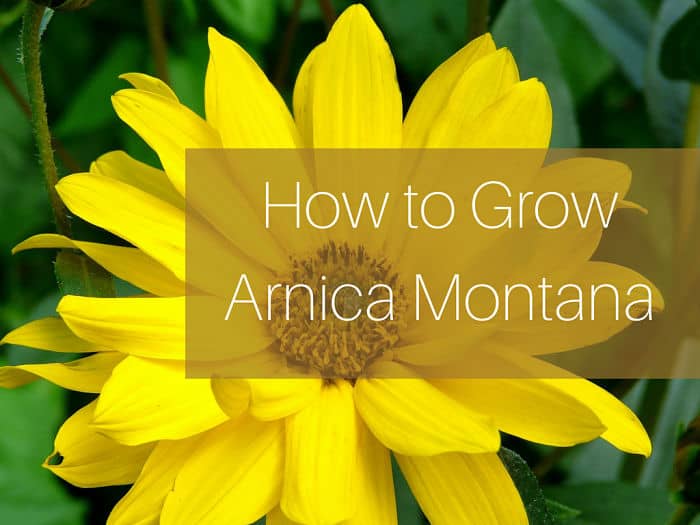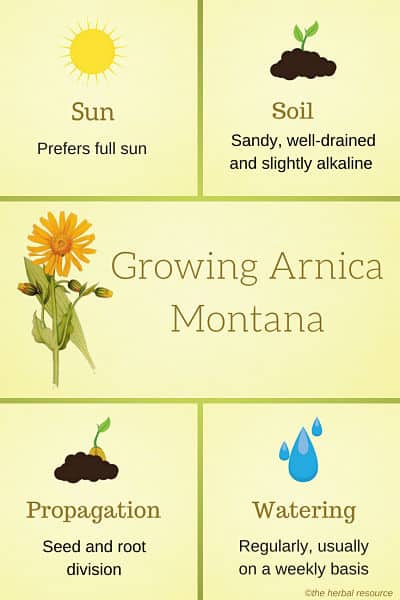Growing arnica is an excellent option for those who love rare and exotic herbs.
It is mostly grown for its medicinal properties but its also great for ornamental purposes due to its lovely yellow flowers that appear in spring and summer.
The Genus “Arnica” contains approximately thirty species, but Arnica montana is the most important and sought-after.
It is a member of the sunflower family (Asteraceae), and it is closely related to asters and daisies.
This plant is a perennial and native to mountainous regions of Europe. Many European countries have listed it under protected species due to its decline, mainly as a result of overharvesting but pollution also plays a part.
Arnica is very sensitive to pollution and it does not thrive in areas that have minimal residual nitrogen, even that which results from air deposition.
Air pollution, together with urbanization and encroaching agriculture provide more reasons as to why this plant is edging closer to extinction in many areas as well as creating a shortage of the medicinal herb for commercial purposes.
Under all these circumstances, it only makes sense to grow Arnica montana.
Propagation
When growing arnica as a garden plant, it is best suited for a temperate climate zone, usually a recommended USDA zone of between 4 and 9.
Since the plants prefer higher elevations and temperate climates, warm, coastal climates can sometimes not be ideal for growing them though this is not entirely impossible.
Arnica is usually propagated from seeds, but it can also be grown by a division from the root of an existing plant.
The seeds usually take about a month to germinate, but in some instances, it can take much longer, so patience is sometimes required.
Sow the seeds in early spring in a shallow tray or another suitable container in a mixture of equal parts loam, peat, and sand. Push the seeds lightly below the surface of the growing medium and keep it moist.
It is best to place them in a cool place with indirect sunlight because the seeds need a chilling period to germinate.
The seedlings can be transplanted outdoors when the danger of frost has passed.
Growing arnica by root division is best done in the autumn after the leaves start withering.
Requirements of Growing Arnica and Care
Looking after the fully grown plants is relatively easy. They do not have many needs to grow, but still, several specific conditions are ideal for optimal growth.
Sun
Arnica prefers full sun, but it can also tolerate some shade, especially in warmer climates. When growing arnica plants in a container, place it in a location that has good exposure to the sun.
Soil
Growing arnica can be done in any type of soil, but it usually prefers sandy, well-drained and slightly alkaline soil.
If the soil is not well drained, it can be amended it with loam, peat, and sand. Also, use a pitchfork to break it up if it is hard clay or otherwise compacted.
Additionally, it produces by way of underground stolons, horizontal stems with nodes that root and shoot new stems up to the surface.
So amending the soil is also beneficial for this purpose since it allows the stolons to penetrate the surface smoothly and promotes the spread of the plant resulting in a good yield.
Watering
Arnica is not a drought-tolerant plant. Therefore, the soil should be kept moist by watering regularly, usually on a weekly basis while ensuring proper drainage.
Do not allow the soil to become too dry or soggy. As a guidance tip, water the plants when the topsoil feels slightly dry.
Fertilizing
Fertilizing the plant is not necessary since arnica can thrive in nutrient-poor soils, which is typical of sub-alpine plants.
Pest and Diseases
The Trypetes arnicivora fly is arnica’s main danger as it places its larvae in the flower heads.
It is one of the reasons why harvesting the flowers immediately after they start flowering is recommended, to avoid colonization of this pest.
Other potential culprits include looper caterpillars, snails, and rabbits, as well as phoma (a genus of common soil fungi).
Arnica is more prone to diseases when under high humidity conditions.
Harvest
Harvest the flowers during mid to late summer soon after they begin to blossom, together with the stems.
Proper drying should be done on screens in a dark, warm and well-ventilated area. Dry until the flowers are crispy. It is recommended to use them immediately after drying, but they can be stored as well for later use.
The roots are harvested in the fall when the plant has withered and dried under the same conditions as the flowers.
Never harvest the plant in the wild.
Toxicity
Arnica contains several toxins such as helenalin that can cause potentially dangerous side effects such as vomiting, internal bleeding, heart irregularities and dizziness.
Ingesting arnica in large amounts can be fatal. The alcoholic extracts of the plant can also be toxic to the heart and can raise blood pressure.
Contact with the herb can result in skin irritation in some people.
Uses of Arnica
Arnica has been used for hundreds of years for medicinal purposes.
Today, its flowers and roots are used in topical treatments such as creams, salves, tinctures, lotions, and ointments.
It is used to relieve sprains and bruises, reduce inflammations, soothe tired muscles, burns, and minor wounds, and ease the itch of insect bites and also to promote hair growth.
The herb exhibits anti-inflammatory, antiseptic, antifungal, antibacterial, antioxidant and antisclerotic activities.
Generally, arnica should only be used topically and never be taken internally or applied on broken skin.
However, there are homeopathic remedies that are extremely diluted and available in pill form which should only be used with the guidance of a professional health care provider due to its toxic nature.
Learn More About the Health Benefits and Uses of Arnica montana
Supporting References
ResearchGate – Propagation and Introduction of Arnica montana L. into Cultivation: A Step to Reduce the Pressure on Endangered and High-Valued Medicinal Plant Species
Thordur Sturluson
Latest posts by Thordur Sturluson (see all)
- What is the Difference Between Hemp and Marijuana? - June 3, 2019


Very helpful. Many thanks
thankyou for the information.
I have a relatively small garden in Brooklyn NY. Does Arnica spread alot?
If so, I would plant it in a container.
thankyou!